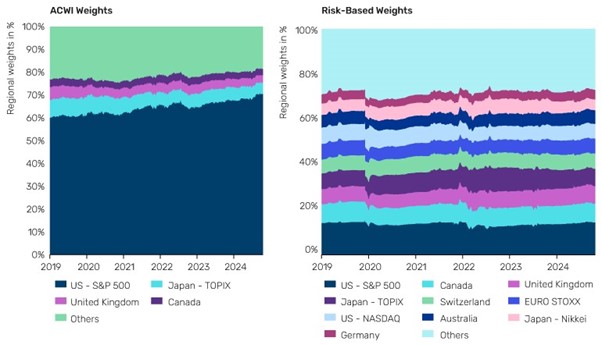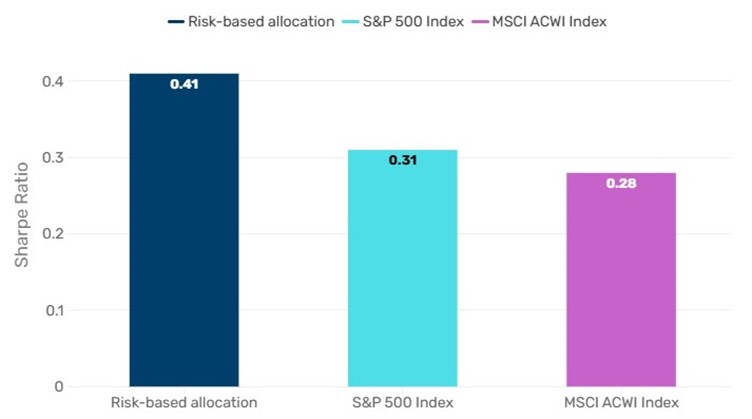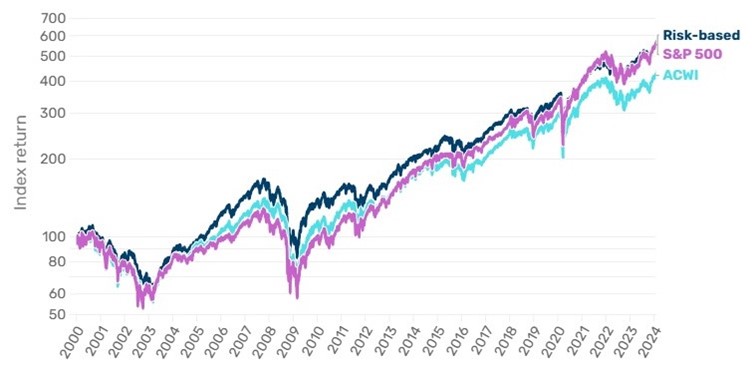Security Alert: Scam Text Messages
We’re aware that some nabtrade clients have received text messages claiming to be from [nabtrade securities], asking them to click a link to remove restrictions on their nabtrade account. Please be aware this is likely a scam. Do not click on any links in these messages. nabtrade will never ask you to click on a link via a text message to verify or unlock your account.
Read this before you go all in on US equities
Tarek Abou Zeid, Peter Weidner, Max Buchanan & Katerina Koutsouri | Man AHL
US equities rule global markets, but history is littered with examples of markets that seemed invincible — until they weren’t.
Forecasting market returns is a fool’s errand, as history has repeatedly shown. Few predicted the 2023 AI-fuelled US tech rally after a bruising 2022, or the sharp bond selloff caused by stubborn inflation. There’s only one certainty: markets remain unpredictable. It’s a feature, not a bug.
For the past decade, US equities have been the undisputed stars, delivering an extraordinary run. The S&P 500, powered by the FAANG/Magnificent Seven stocks1, has vastly outperformed the majority of its global peers, giving rise to the US exceptionalism narrative.
But no market dominates forever. Japan ruled the 1980s, emerging markets were the darlings of the 2000s, and even Europe has had its moments in the sun. The US, while formidable, is not immune to weak performance.
This raises a critical question for investors: should you go 'all in' on US equities, riding the momentum of their recent strength, or should you consider a more diversified approach? After all, the smart money forecasts risks, not returns.
Diversification isn’t always as it seems
The conventional response is to allocate to global equities, such as the MSCI All Country World Index (ACWI), which spreads exposure across regions but remains heavily skewed towards US equities. That means a downturn in the US — whether sparked by rising interest rates, US President Donald Trump’s policies, Chinese AI developments, or any other unknown — can still leave your portfolio vulnerable.
Shifting the focus from returns to risk and constructing a portfolio that allocates based on diversification and risk balancing can produce a more robust solution. As Figure 1 shows, the ACWI concentrates heavily in US equities, while a risk-based approach allocates more evenly across regions such as Europe, Japan, and emerging markets. This ensures portfolios are better diversified and less tethered to the fortunes of one economy.
Figure 1. A balanced approach to global diversification

Source: MSCI, Man Group, as at January 2025.
While the S&P 500 has delivered strong returns over the past two decades, a risk-based allocation has delivered better risk-adjusted returns. As Figure 2 shows, a risk-based allocation outperforms both the S&P 500 and the MSCI ACWI Index in terms of Sharpe ratio (i.e., investors are better compensated for every unit of risk they take on). Crucially, this approach doesn’t require a crystal ball. It is not about predicting the next big winner but about creating a portfolio that is designed to navigate diverse market conditions without sacrificing upside potential.
Figure 2. Better risk-adjusted returns

Source: Bloomberg, Man Group, as at January 2025.
In equity investing, while risk-adjusted metrics like the Sharpe ratio are valuable, they rarely satisfy investors on their own. In risk-on environments, the focus inevitably shifts to delivering absolute returns — because, as the old adage goes, ‘you can’t eat Sharpe ratio.’
As Figure 3 highlights, a risk-based allocation strategy not only outpaced the MSCI ACWI but also kept pace with the S&P 500, doing so at a lower volatility — a compelling proposition for investors.
Figure 3. A smoother ride – the returns of a risk-based approach compared with the MSCI ACWI and the S&P 500

Source: Bloomberg, Man Group, as at January 2025.
The allure of US equities is understandable. They have been the stars of the investment world for years, and their track record is hard to ignore. But history is littered with examples of markets that seemed invincible—until they weren’t.
So, before you go 'all in' on the US juggernaut, consider whether there’s a better way to diversify. Because in investing, as in life, betting everything on one idea is rarely the safest path.
First published on the Firstlinks Newsletter. A free subscription for nabtrade clients is available here.
All data Bloomberg unless otherwise stated.
1. FAANG was the original group of tech superstar stocks Facebook (now Meta Platforms, Inc.), Amazon, Apple, Netflix, Google (now Alphabet, Inc.), that morphed into the Magnificent Seven, dropping Netflix, and adding Nvidia, Tesla and Microsoft.
All prices and analysis at 19 February 2025. This document was originally published on firstlinks.com.au on 19 February has been prepared by Man Investments Australia Limited (ABN 47 002 747 480)(AFSL 240581). The content is distributed by WealthHub Securities Limited (WSL) (ABN 83 089 718 249)(AFSL No. 230704). WSL is a Market Participant under the ASIC Market Integrity Rules and a wholly owned subsidiary of National Australia Bank Limited (ABN 12 004 044 937)(AFSL No. 230686) (NAB). NAB doesn’t guarantee its subsidiaries’ obligations or performance, or the products or services its subsidiaries offer. This material is intended to provide general advice only. It has been prepared without having regard to or taking into account any particular investor’s objectives, financial situation and/or needs. All investors should therefore consider the appropriateness of the advice, in light of their own objectives, financial situation and/or needs, before acting on the advice. Past performance is not a reliable indicator of future performance. Any comments, suggestions or views presented do not reflect the views of WSL and/or NAB. Subject to any terms implied by law and which cannot be excluded, neither WSL nor NAB shall be liable for any errors, omissions, defects or misrepresentations in the information or general advice including any third party sourced data (including by reasons of negligence, negligent misstatement or otherwise) or for any loss or damage (whether direct or indirect) suffered by persons who use or rely on the general advice or information. If any law prohibits the exclusion of such liability, WSL and NAB limit its liability to the re-supply of the information, provided that such limitation is permitted by law and is fair and reasonable. For more information, please click here.
